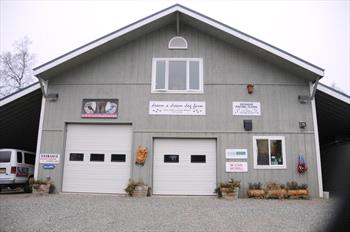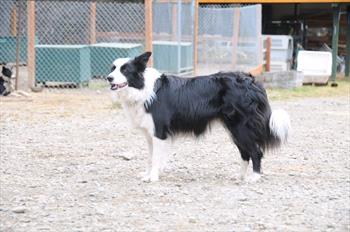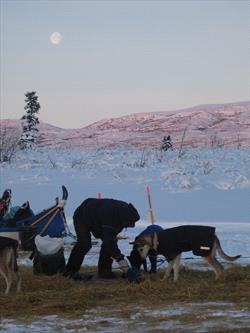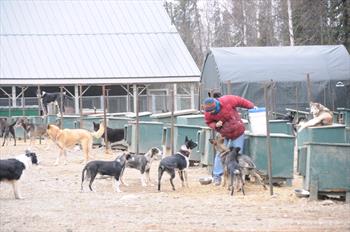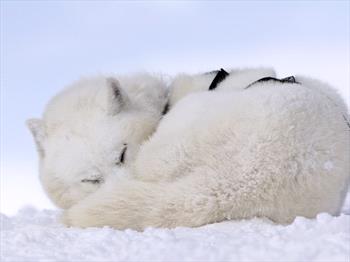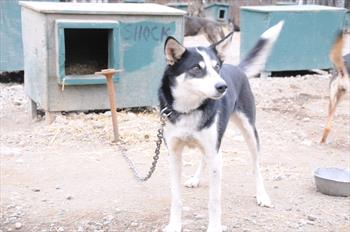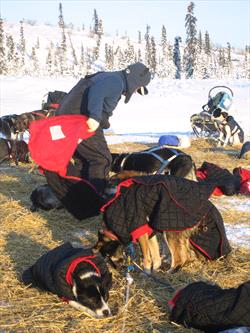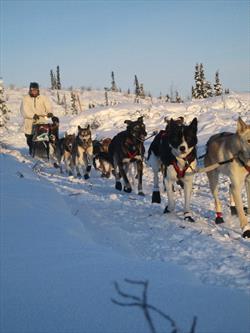
Brrr. It’s below 20° and the only sane place for a person is sitting inside in a nice cozy, heated home. But what about your dog? While I generally recommend all pets stay inside too, some dogs love being outdoors and were bred for cold weather—when is it safe for dogs to stay outside in the cold?
I had the extreme good fortune to meet veterinarian, Dr. Susan Whiton on a recent trip to Anchorage, Alaska. She provided a personal tour of her sled dog kennel and told me how she and her husband, top musher Vern Halter, own Dream a Dream Iditarod Sled Dog Kennel. For 21 years Vern has raced the Iditarod or Yukon Quest. He has placed in the top 5 of the Iditarod three times and the top 10 eight times. Susan has focused most of her work attending to the dog’s medical and health needs. In addition to her veterinary degree, Susan has completed the IVAS animal acupuncture course and studied both canine physical rehabilitation as well as osteopathy. Susan has even raced in the Yukon Quest herself, just for fun! So I knew there was no one more qualified to answer your questions about dogs in cold weather than Susan!
Here are some of Susan Whiton’s tips on cold weather safety for dogs.
Question:
Which dogs can tolerate cold weather?
Answer:
The animal’s ability to tolerate really cold weather depends on age, nutritional status, health and coat density. The northern breeds with the thick undercoat do the best: Siberian Huskies, Alaskan Huskies, Malamutes, etc.
My Gordon Setter (long since passed away) could be outside in a well-strawed dog house at 20° below for the 8 hours when I was at work, but she slept inside at night and she was on a high-fat, high-protein performance dog food. She lived in Alaska her adult life and grew a thick coat over the winter.
My current border collie Jesse tolerates the cold temperatures very well. Her coat is very thick and she eats the same high-energy food and high fat treats that the sled dogs do. She can be outside all day in the bitter cold but comes inside at night.
My 15-year old border collie can only be outside for 15–20 minutes before she starts shivering. When she was younger she was just like Jesse in her tolerance for cold.
Puppies under 8 weeks of age do not tolerate the deep cold at all even the double-coated breeds. Their ability to regulate their body temperature does not even begin to develop until they are around 2 weeks of age. As they start to eat solid food we start taking them out for monitored amounts of time. We have some 8 week old pups that are outside all day long if it is -10°F or warmer. If we see them just huddling in their dog house and not playing we bring them back inside. Health, nutritional status, diet, thickness of hair-coat and body mass affect how quickly they will develop a tolerance to the cold. A thick-coated fluffy Pomeranian at one pound will not be able to tolerate the cold as well as the 10 pound husky pup.
Question:
How do you know when it’s too cold for your dog?
Answer:
If your dog is shivering or refusing to come out of its dog house or a curled position it is probably too cold.
Question:
What diet should they eat if they are outside for long periods during the day?
Answer:
The calories in most commercial dog foods come from carbohydrates. In very cold weather, the dogs do better with a higher amount of fat calories. A study indicated a sled dog racing the Iditarod required 10,000 calories a day to meet their metabolic needs. The only way to meet that high caloric need is with a diet high in fat calories. Most pet dogs do not need that many calories and may get very sick from a high fat diet.
When I ran the Yukon Quest in 1987 we encountered -55° F temperatures at night and -20° F during the day. The sled dogs did fine at those temperatures. They were being fed a very high fat, high calorie diet up to four times a day during the rest periods and often got fatty meat snacks during the runs.
Question:
How are dogs with a thick undercoat able to keep warm when sleeping?
Answer:
When they sleep they curl up with their tail over their nose, which traps the heat against their bodies. There are lots of photos of resting sled dogs covered with snow. They are holding their heat well since the snow is not melted. The dogs that are not doing well will have ice on their fur. It indicates that they are losing enough body heat to melt the snow. Because their coat is not insulating well more ice will build up making the hair less lofty and less insulating. The thick undercoat of the Northern Breeds provides loft, like a fuzzy mohair sweater, and keeps the warmth next to the animal rather than allowing it to escape. The Iditarod sled dog race only allows Northern Breeds in the race because other breeds can’t retain heat well. So when the ice hits their coat it melts and then freezes.
Question:
What type of housing is warm enough for sub zero temperature?
Answer:
Our sled dogs have individual houses big enough for them to move around inside but small enough to allow them to be warmed with body heat. The houses all have legs that raise them off the ground. The space under the houses provides insulation from the frozen ground. We constantly monitor the straw to keep it dry because damp straw would soon be frozen to the bottom of the doghouse which would be frozen to the ground making it harder to keep the bedding dry.
There is a thick layer of straw inside every house and we add new straw at every cold snap to replace the loft. The old straw is removed and replaced with new straw several times over the winter because it will get damp from the snow that the dogs bring in on their fur. Wet straw loses its ability to insulate. It is important that the dryness of the straw be monitored and replaced if it gets damp. Sometimes the boy dogs miss when they mark the corner of their houses and the straw gets wet from other liquids.
Question:
How do you keep dogs warm during a race?
Answer:
Cold is not a problem when the dogs are running during the race. Overheating is a bigger problem for the sled dogs. I raced in the Rocky Mountain Stage Stop Race out of Jackson Hole, Wyoming. The temperatures there were often in the high twenties and low thirties. My cold weather dogs from Alaska had trouble with the heat. They got frozen meat water as treats rather than fat as a snack to keep them cooler. Think of a hardy Minnesotan running the Ironman in the heat and humidity of Hawaii. It must have been like that for my dogs.
The dogs do need to stay warm when they stop at the checkpoints for their rest. There is a fresh bale of straw for every team at every checkpoint on the Iditarod. Every musher will make straw beds for the dogs at every rest. Many mushers also have fleece dog coats and blankets to put on top of the dogs as they sleep for extra warmth. Vern (my husband) had special insulated dog coats with pockets on the inside for hand warmers. He used these coats at the 24-hour rest period to provide extra warmth so the dogs would be warm without curling up. They could sleep warm with their legs and back stretched and relaxed, allowing for better recovery. The dogs sleep on the line and sometimes curl up with the neighboring dogs but usually just snuggle into their individual straw beds.
The sled dogs will wear nylon and fleece coats during the run in windy weather to protect the un-haired parts on the underside. The tip of the sheath on males is vulnerable to frost bite in very cold weather when it is windy. The booties protect the feet from the abrasive snow but they do not add warmth. In very cold temperatures the snow becomes harsh like sandpaper and the dogs must wear booties to protect their feet.
So there you have it. Insights from an expert. While, I know, my little JRT would not enjoy sleeping in the cold, but for dogs bred for and raised in cold climates, the story is different. Whiton adds, “It is hard for humans who think 30 F is cold to imagine dogs doing well at -30° F.
But the dogs do amazingly well if they are acclimated, healthy, fed well and housed well.”
To learn more about cold weather safety for dogs, read Six Cold Weather Tips in Dogs and Cats and Cold Weather Safety in Dogs and Cats.


